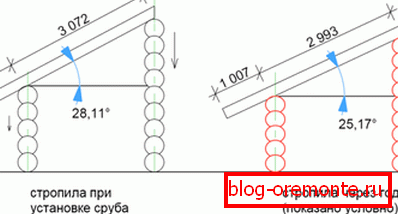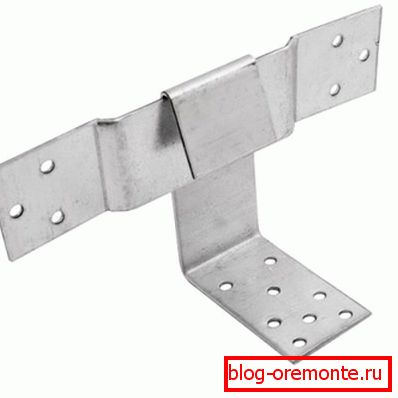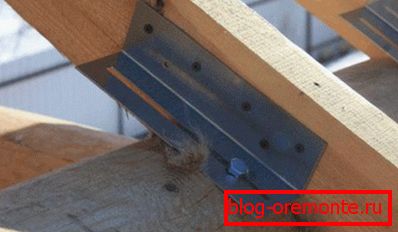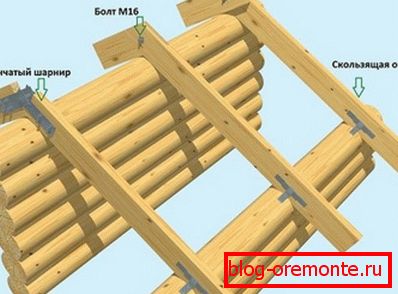Sliding support for rafters, the use of a sliding truss
Despite the abundance of modern building materials, distinguished by a long service life and affordable cost, natural wood does not lose its leading position in private housing construction for centuries, thanks to environmental safety and exceptional energy efficiency. However, the construction of lumber or log houses raises one problem - the strong shrinkage of the structure, which does not allow to block it immediately after construction. Because of this peculiarity of the material, it is impossible to immediately proceed to the interior decoration and move to a new home. To prevent roof deformation during shrinkage will help a special device - sliding rafters, the device which we describe in our article.
Device
Sliding supports for rafters call a special device, which is necessary to connect the truss elements to each other, but leave them with a small power reserve, preventing deformation of the structure during shrinkage. In everyday life, these fasteners are often called sliders or skids. They consist of two parts, one of which is fixed and the other is capable of sliding. Sliding supports are made of a strong, corrosion resistant metal that can withstand heavy loads. The advantages of this method of mounting rafters consider:
- The ability of the roof to change its geometry in the process of shrinkage, so that the construction of the roof can be performed immediately after the completion of the construction of a wooden house, without waiting for the complete drying of the wood.
- Facilitating the process of attaching rafters. The use of special movable fasteners reduces the proportion of manual labor in the assembly of the rafter frame, reduces the time spent on roofing.
- Provides a secure fit. The sliding supports manufactured in the factory undergo several stages of quality checks, therefore they are guaranteed to withstand snow and wind loads, which the rafters undergo during operation.
Note that movable rafters for rafters are subject to intense loads during operation, so they are made only of high-strength, low-carbon steel not less than 2 mm thick.

Functions
Shrinkage - the process of changing the size of wooden buildings due to the decrease in moisture content of wood, which lasts for 1-3 years from the date of construction. The most active shrinkage occurs in the first year, during which the house may become lower by 1-2 widths of 1-2 crowns. It is because of this property of the tree that it is not recommended to perform roof overlapping immediately after construction. Sliding support for rafters solves this problem by performing the following functions in the design of the truss frame:
- Prevent deformation of rafters in the process of shrinkage of a wooden house. Thanks to such a movable system, the rafter legs adapt to the size and geometry of the structure, compensating for expansion loads that the bearing walls are subjected to.
- Ensuring the mobility of the frame during operation. Wood is a natural material that, during operation, even after the end of the shrinkage process, can change its humidity and size. Wooden houses are said to be “breathing”, so the roof frame of the roof should adapt to them, also changing dimensions with increasing or decreasing humidity.


Note! Many people believe that if the rafters and the box of the house are made of the same material, then the rafter system will not be deformed during the shrinking process. In fact, the shrinkage of different construction nodes is uneven. When this happens, the size and geometry of the frame elements are changed in several planes at once.
Species
The use of movable fasteners for fixing rafter legs to the mauerlat is the only way to prevent roof deformation during the shrinkage of wooden houses. As a rule, sliders have a rather typical construction consisting of a static base-guide and a corner with a loop that moves along it. There are the following types of mobile fasteners:
- Open type Sliding fasteners for open-type rafters are a folding structure consisting of a guide, firmly fixed to the rafter, and a corner, which is attached to the rafter frame. Different models differ in just 2 factors: the number of mounting holes, which can be from 1 to 5, as well as a power reserve. The minimum power reserve of the sliding bearing is only 60 mm, and the minimum - 160 mm. The larger this parameter is, the better the fastener protects against deformation, ensuring maximum mobility of the rafters.

- Closed type. The sliding support of rafters closed, in difference from open, does not gather and does not understand. This is a solid, monolithic construction, which is sold and installed immediately assembled. In this case, the corner attached to the power plate has a loop through which, during the manufacturing process of the mount, the guide bar is held and fixed to the rafter.

Professional roofing masters consider that movable mounts for open-type rafters are much more convenient for installation, especially if the truss framework is assembled by an inexperienced worker. On the other hand, closed supports are more reliable in operation and can withstand heavy loads.


Mounting technology
The process of assembling the roof truss frame using movable mounts is not much different from the standard procedure. ABOUTHowever, it requires maximum dimensional accuracy in the manufacture of elements, as well as the exposure of the same angle between the base of the roof and the end of the truss foot during its installation. The trussing system is installed in the following order:
- First, on the bearing walls of the house stack mauerlat. This element of the truss frame of the roof performs support functions, evenly distributing the load between the supports and transferring them to the foundation. In log or log houses, the upper rims can perform the Mauerlat function.
- Make a template truss legs, which will become a model for the manufacture of all the other rafters design.
- At the end of each truss foot do the gash under the power plate. Experienced craftsmen note that in no case should one make cuttings in the power plate, as this reduces its strength and carrying capacity.
- First, the first and last truss pair are installed, carefully checking the angle between the elements with the help of a verified building level.
- The support sliding for rafters fastens on the lower end of a leg. To ensure reliable fixation, it is necessary to fix the guide and slider with 2-3 fasteners.
- The upper ends of the truss legs in the area of the ridge joint are fixed with the help of nails or metal plates connected with a stud, ensuring the mobility of the structure.
- Between the first and last truss pair tension the cord, and then install the rest of the structure.
Remember that the choice of the length of the guide bar movable mount depends on the possible amount of shrinkage at home. The greater the moisture content of the wood used for construction, the greater must be the size of the sled.
